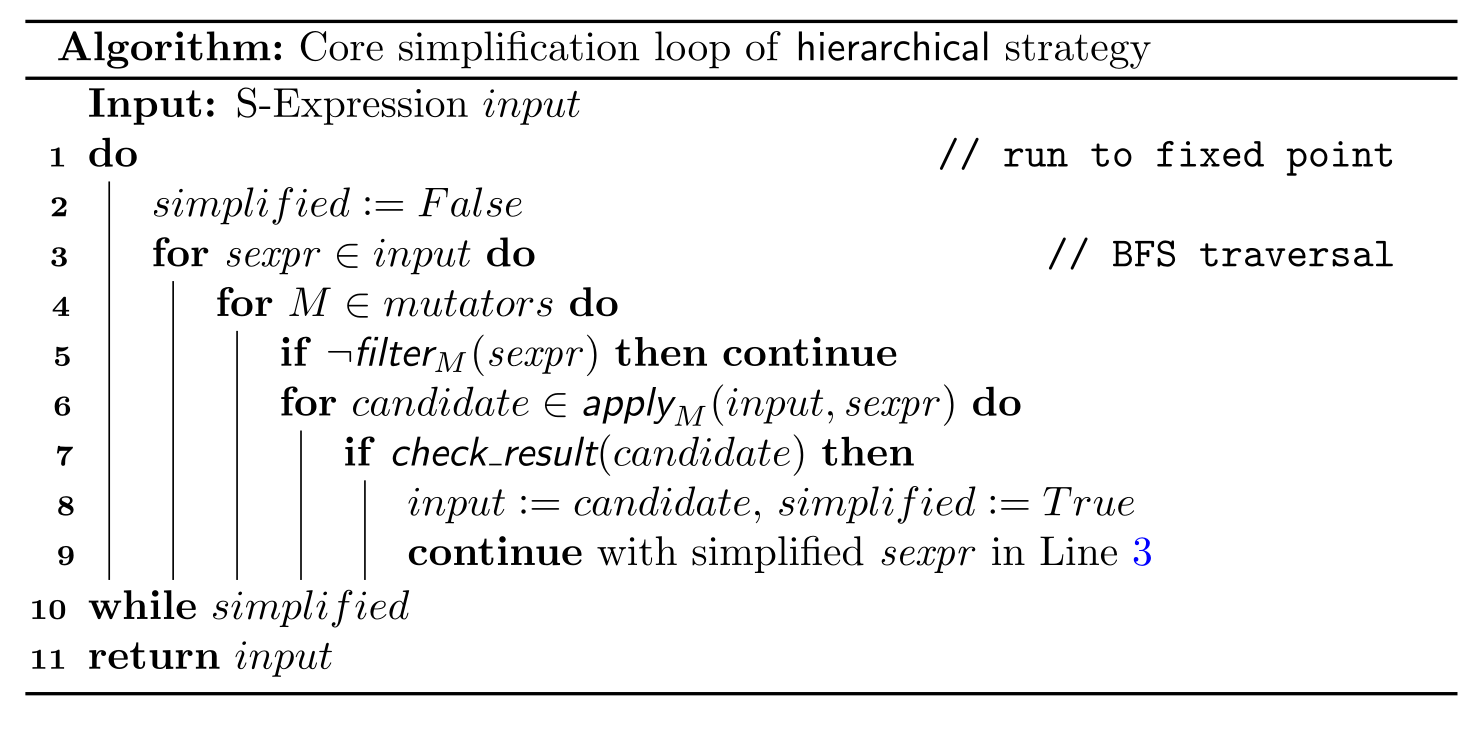Minimization Strategies¶
ddSMT implements two fundamentally different strategies for input minimization (ddmin and hierarchical), which can be combined into the best of both worlds, strategy hybrid.
Strategy ddmin implements a variant of the minimization strategy from [Zel99], and is the direct successor of what the original ddSMT from [NB13] implemented: it tries to perform mutations on multiple S-expressions in the input in parallel. Strategy hierarchical performs a simple breadth-first traversal through the input and applies mutations to every S-expression, one mutation at a time (similar to what is presented as “hierarchical delta-debugging” in [BB09]). Strategy hybrid is the default strategy of ddSMT. It first applies ddmin until a fixed point is reached, and then calls strategy hierarchical on the simplified input.
For a more in-depth analysis of these minimization strategies, see [KNP21].
The ddmin Strategy¶
Strategy ddmin tries to perform simplifications on multiple S-expressions
in the input in parallel.
The algorithm below shows the main loop of ddmin in pseudo code.
For each active mutator M, the algorithm first collects all
S-expressions in the input that can be simplified by M (Line 4).
Simplifications are applied and checked in a fashion similar to the original
ddmin algorithm [ZH02]:
the set of S-expressions
sexprsis partitioned into subsets of sizesizeeach S-expression
efromsubsetis substituted in the currentinput(Line 7) with a simplification suggested by mutatorMthe resulting simplified input candidate is then checked if it still triggers the original behavior from the golden run (Line 8)
Once all subsets of a given size are checked, sexprs is updated based
on the current input and partitioned into smaller subsets.
As soon as all subsets of size 1 were checked, these steps are repeated
with the next mutator.
This loop is run until the input cannot be further simplified.
ddmin applies mutators in two stages. The first stage targets top-level S-expressions (e.g., specific kinds of SMT-LIB commands) until a fixed point to aggressively simplify the input before applying more expensive mutators in the second stage.

The hierarchical Strategy¶
The main loop of the hierarchical strategy (as shown in pseudo code below)
performs a simple breadth-first traversal
of the S-expressions in the input, and applies all enabled mutators
to every S-expression.
Once a simplification is found (Line 7), all pending checks for the current
S-expression are aborted and the breadth-first traversal continues with the
simplified S-expression sexpr (Line 9).
This process is repeated until further simplifications are found.
The main simplification loop (Line 3) is applied multiple times, with varying sets of mutators. In the initial stages, hierarchical aims for aggressive minimization using only a small set of selected mutators, in the next-to-last stage it employs all but a few mutators that usually only have cosmetic impact, and in the last stage it includes all mutators.
Breadth-first traversal yields significantly better results than a depth-first traversal, most probably since it tends to favor simplifications on larger subtrees of the input.

The hybrid Strategy¶
Strategy hybrid is the default strategy of ddSMT. It combines strategies ddmin and hierarchical in a sequential portfolio manner for a best of both worlds.
Strategy hybrid first applies ddmin until a fixed point is reached, and then calls strategy hierarchical on the simplified input. This order of strategies is due to our observation that ddmin is usually faster in simplifying input, while hierarchical often yields smaller inputs.